Caio Graco-Roza
@gracoroza.bsky.social
I am an ecologist starting a research group at the Lammi Biological Station (University of Helsinki). In my free time, I enjoy playing music and going to the gym. I have 🐈 🐈⬛ and I’m proudly Brazilian—wholeheartedly!
This says a lot about the fact that most prestigious international journals are in western countries. More of them in Eastern countries and we would have another setting of holidays. On a funny note, here in Finland, the most relevant call for funding has its deadline on January 8th. It bugs me…
December 23, 2024 at 8:13 AM
This says a lot about the fact that most prestigious international journals are in western countries. More of them in Eastern countries and we would have another setting of holidays. On a funny note, here in Finland, the most relevant call for funding has its deadline on January 8th. It bugs me…
Working on and publishing, please add me! 🫣
December 11, 2024 at 5:57 PM
Working on and publishing, please add me! 🫣
J’aimerais bien être ajouter. Merci!
December 8, 2024 at 5:45 PM
J’aimerais bien être ajouter. Merci!
Would you add me, please? 😃
December 7, 2024 at 8:48 AM
Would you add me, please? 😃
Hi Brian, would you mind adding me to the list? Thanks 😃
December 4, 2024 at 5:24 PM
Hi Brian, would you mind adding me to the list? Thanks 😃
Hi, would you please add me to this list :)?
December 4, 2024 at 5:23 PM
Hi, would you please add me to this list :)?
12/ 📢 Still a Preprint
This work is currently a preprint, and we welcome any comments, feedback, or criticism! 📝
You can access the full text and code to explore the details and share your impressions: doi.org/10.21203/rs.....
Let’s discuss! 💡
This work is currently a preprint, and we welcome any comments, feedback, or criticism! 📝
You can access the full text and code to explore the details and share your impressions: doi.org/10.21203/rs.....
Let’s discuss! 💡
Human pressure homogenises species and traits globally
Human pressures, particularly urbanisation and agricultural expansion, profoundly affect biodiversity by reshaping species and functional trait distributions, with critical consequences for ecosystem ...
doi.org
December 4, 2024 at 11:39 AM
12/ 📢 Still a Preprint
This work is currently a preprint, and we welcome any comments, feedback, or criticism! 📝
You can access the full text and code to explore the details and share your impressions: doi.org/10.21203/rs.....
Let’s discuss! 💡
This work is currently a preprint, and we welcome any comments, feedback, or criticism! 📝
You can access the full text and code to explore the details and share your impressions: doi.org/10.21203/rs.....
Let’s discuss! 💡
11/2 🙌 Core Team
The core team behind this work included:
Myself (@gracoroza /
@gracoroza.bsky.social
)
@MarkKLWong /
@markklwong.bsky.social
@altermatt_lab /
@florianaltermatt.bsky.social
Martin Gossner, who is not on social media
The core team behind this work included:
Myself (@gracoroza /
@gracoroza.bsky.social
)
@MarkKLWong /
@markklwong.bsky.social
@altermatt_lab /
@florianaltermatt.bsky.social
Martin Gossner, who is not on social media
December 4, 2024 at 11:38 AM
11/2 🙌 Core Team
The core team behind this work included:
Myself (@gracoroza /
@gracoroza.bsky.social
)
@MarkKLWong /
@markklwong.bsky.social
@altermatt_lab /
@florianaltermatt.bsky.social
Martin Gossner, who is not on social media
The core team behind this work included:
Myself (@gracoroza /
@gracoroza.bsky.social
)
@MarkKLWong /
@markklwong.bsky.social
@altermatt_lab /
@florianaltermatt.bsky.social
Martin Gossner, who is not on social media
12/ 📢 Still a Preprint
This work is currently a preprint, and we welcome any comments, feedback, or criticism! 📝
You can access the full text and code to explore the details and share your impressions: https://doi.org/10.21203/rs.3.rs-5395446/v1.
Let’s discuss! 💡
This work is currently a preprint, and we welcome any comments, feedback, or criticism! 📝
You can access the full text and code to explore the details and share your impressions: https://doi.org/10.21203/rs.3.rs-5395446/v1.
Let’s discuss! 💡
December 4, 2024 at 11:36 AM
12/ 📢 Still a Preprint
This work is currently a preprint, and we welcome any comments, feedback, or criticism! 📝
You can access the full text and code to explore the details and share your impressions: https://doi.org/10.21203/rs.3.rs-5395446/v1.
Let’s discuss! 💡
This work is currently a preprint, and we welcome any comments, feedback, or criticism! 📝
You can access the full text and code to explore the details and share your impressions: https://doi.org/10.21203/rs.3.rs-5395446/v1.
Let’s discuss! 💡
11/2 🙌 Core Team
The core team behind this work included:
Myself (@gracoroza / @gracoroza.bsky.social)
@MarkKLWong / @markklwong.bsky.social
@altermatt_lab / @florianaltermatt.bsky.social
Martin Gossner, who is not on social media
The core team behind this work included:
Myself (@gracoroza / @gracoroza.bsky.social)
@MarkKLWong / @markklwong.bsky.social
@altermatt_lab / @florianaltermatt.bsky.social
Martin Gossner, who is not on social media
December 4, 2024 at 11:36 AM
11/2 🙌 Core Team
The core team behind this work included:
Myself (@gracoroza / @gracoroza.bsky.social)
@MarkKLWong / @markklwong.bsky.social
@altermatt_lab / @florianaltermatt.bsky.social
Martin Gossner, who is not on social media
The core team behind this work included:
Myself (@gracoroza / @gracoroza.bsky.social)
@MarkKLWong / @markklwong.bsky.social
@altermatt_lab / @florianaltermatt.bsky.social
Martin Gossner, who is not on social media
11/1 🙌 Acknowledgements
This work was only possible thanks to the incredible amount of open-access data and a huge collaborative effort involving over 20 authors from around the world. 🌍
This research was part of the Blue Green Biodiversity (BGB) initiative, a collaboration between EAWAG and WSL.
This work was only possible thanks to the incredible amount of open-access data and a huge collaborative effort involving over 20 authors from around the world. 🌍
This research was part of the Blue Green Biodiversity (BGB) initiative, a collaboration between EAWAG and WSL.
December 4, 2024 at 11:36 AM
11/1 🙌 Acknowledgements
This work was only possible thanks to the incredible amount of open-access data and a huge collaborative effort involving over 20 authors from around the world. 🌍
This research was part of the Blue Green Biodiversity (BGB) initiative, a collaboration between EAWAG and WSL.
This work was only possible thanks to the incredible amount of open-access data and a huge collaborative effort involving over 20 authors from around the world. 🌍
This research was part of the Blue Green Biodiversity (BGB) initiative, a collaboration between EAWAG and WSL.
10/ 🚀 What’s Next?
To truly understand biodiversity loss, we need global collaboration, long-term monitoring, and policy changes that integrate functional diversity into urban planning and conservation.
To truly understand biodiversity loss, we need global collaboration, long-term monitoring, and policy changes that integrate functional diversity into urban planning and conservation.
December 4, 2024 at 11:36 AM
10/ 🚀 What’s Next?
To truly understand biodiversity loss, we need global collaboration, long-term monitoring, and policy changes that integrate functional diversity into urban planning and conservation.
To truly understand biodiversity loss, we need global collaboration, long-term monitoring, and policy changes that integrate functional diversity into urban planning and conservation.
9/ 💡 Why This Matters
Ecosystem resilience relies on functional diversity—the traits that allow ecosystems to function 🌱⚙️.
Homogenised traits mean ecosystems are less adaptable to change 🔄⚠️.
Conservation strategies must:
Protect minimally impacted habitats 🌳.
Promote habitat heterogeneity 🌾.
Ecosystem resilience relies on functional diversity—the traits that allow ecosystems to function 🌱⚙️.
Homogenised traits mean ecosystems are less adaptable to change 🔄⚠️.
Conservation strategies must:
Protect minimally impacted habitats 🌳.
Promote habitat heterogeneity 🌾.
December 4, 2024 at 11:36 AM
9/ 💡 Why This Matters
Ecosystem resilience relies on functional diversity—the traits that allow ecosystems to function 🌱⚙️.
Homogenised traits mean ecosystems are less adaptable to change 🔄⚠️.
Conservation strategies must:
Protect minimally impacted habitats 🌳.
Promote habitat heterogeneity 🌾.
Ecosystem resilience relies on functional diversity—the traits that allow ecosystems to function 🌱⚙️.
Homogenised traits mean ecosystems are less adaptable to change 🔄⚠️.
Conservation strategies must:
Protect minimally impacted habitats 🌳.
Promote habitat heterogeneity 🌾.
8/ 🔄 Fig. 5: Species vs Trait Mismatch
-While 59.3% of datasets show species and traits changing in the same direction, traits are disproportionately homogenised 📏🌱.
-No differences in effect magnitude, but baseline pressure shapes responses.
-Exponential ↗️ and saturating ➡️ turnover often pair.
-While 59.3% of datasets show species and traits changing in the same direction, traits are disproportionately homogenised 📏🌱.
-No differences in effect magnitude, but baseline pressure shapes responses.
-Exponential ↗️ and saturating ➡️ turnover often pair.
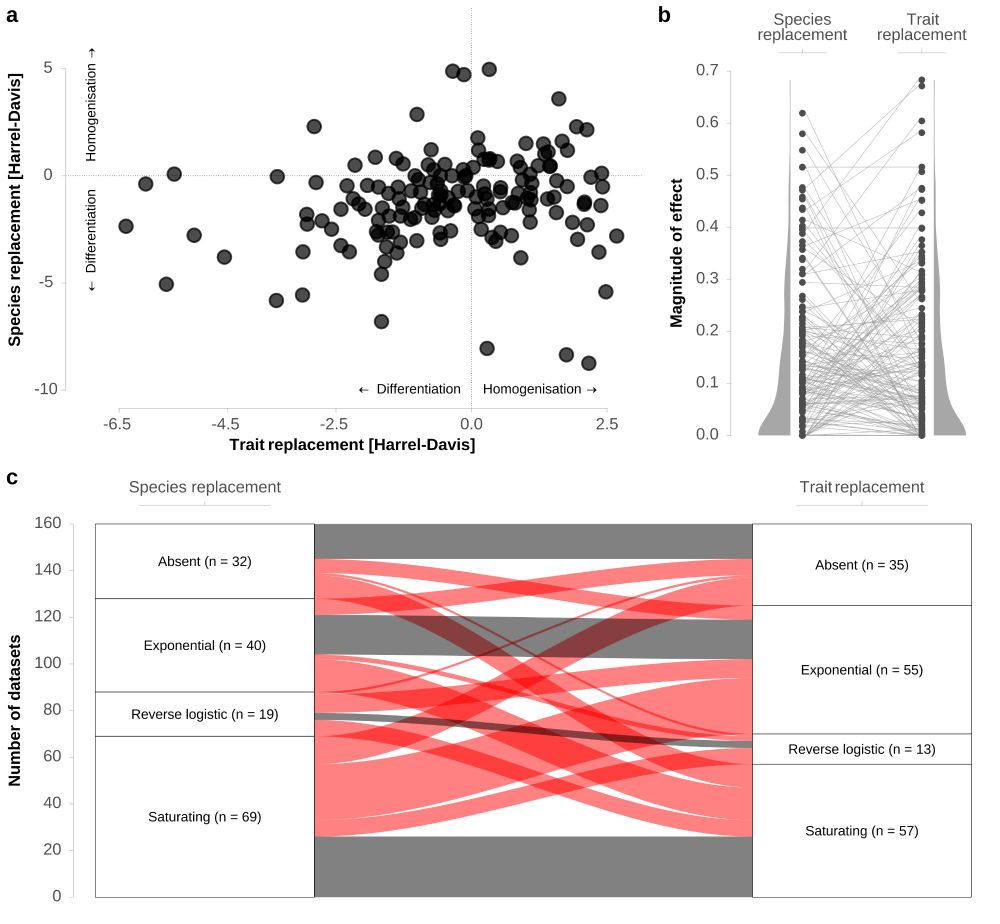
December 4, 2024 at 11:36 AM
8/ 🔄 Fig. 5: Species vs Trait Mismatch
-While 59.3% of datasets show species and traits changing in the same direction, traits are disproportionately homogenised 📏🌱.
-No differences in effect magnitude, but baseline pressure shapes responses.
-Exponential ↗️ and saturating ➡️ turnover often pair.
-While 59.3% of datasets show species and traits changing in the same direction, traits are disproportionately homogenised 📏🌱.
-No differences in effect magnitude, but baseline pressure shapes responses.
-Exponential ↗️ and saturating ➡️ turnover often pair.
7/ 🔄 Fig. 4: The Shape of Turnover
Species and trait turnover face tipping points under intense pressure.
Saturating responses dominate species turnover (43.7%) 🐟🌳, showing high sensitivity to small pressures.
Exponential responses dominate traits (34.4%) 🌆🌱, especially in urban areas.
Species and trait turnover face tipping points under intense pressure.
Saturating responses dominate species turnover (43.7%) 🐟🌳, showing high sensitivity to small pressures.
Exponential responses dominate traits (34.4%) 🌆🌱, especially in urban areas.
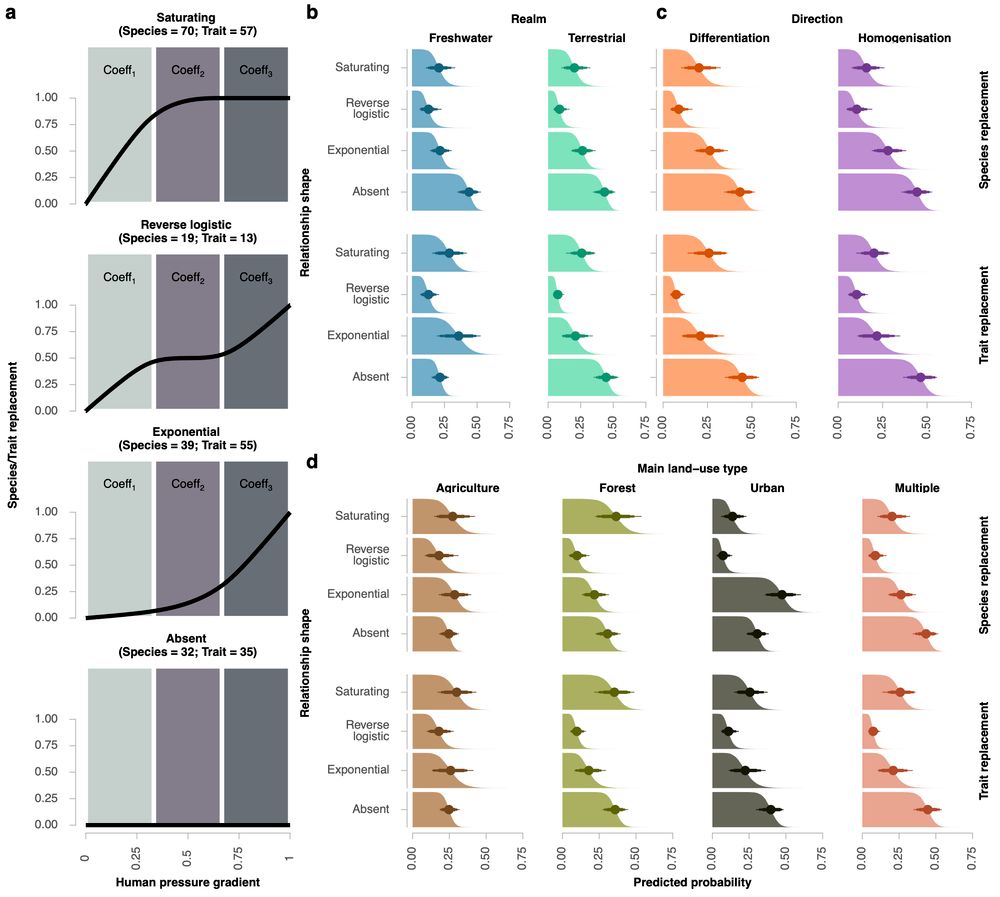
December 4, 2024 at 11:36 AM
7/ 🔄 Fig. 4: The Shape of Turnover
Species and trait turnover face tipping points under intense pressure.
Saturating responses dominate species turnover (43.7%) 🐟🌳, showing high sensitivity to small pressures.
Exponential responses dominate traits (34.4%) 🌆🌱, especially in urban areas.
Species and trait turnover face tipping points under intense pressure.
Saturating responses dominate species turnover (43.7%) 🐟🌳, showing high sensitivity to small pressures.
Exponential responses dominate traits (34.4%) 🌆🌱, especially in urban areas.
6/ 📊 Fig. 3: Homogenisation Hits Harder
Differentiation is more frequent, but human pressures drive homogenisation much more strongly.
Urban areas are hotspots, with 73.3% of urban datasets showing trait homogenisation.
This intense impact leaves ecosystems fragile and less adaptable. 🌇⚠️
Differentiation is more frequent, but human pressures drive homogenisation much more strongly.
Urban areas are hotspots, with 73.3% of urban datasets showing trait homogenisation.
This intense impact leaves ecosystems fragile and less adaptable. 🌇⚠️
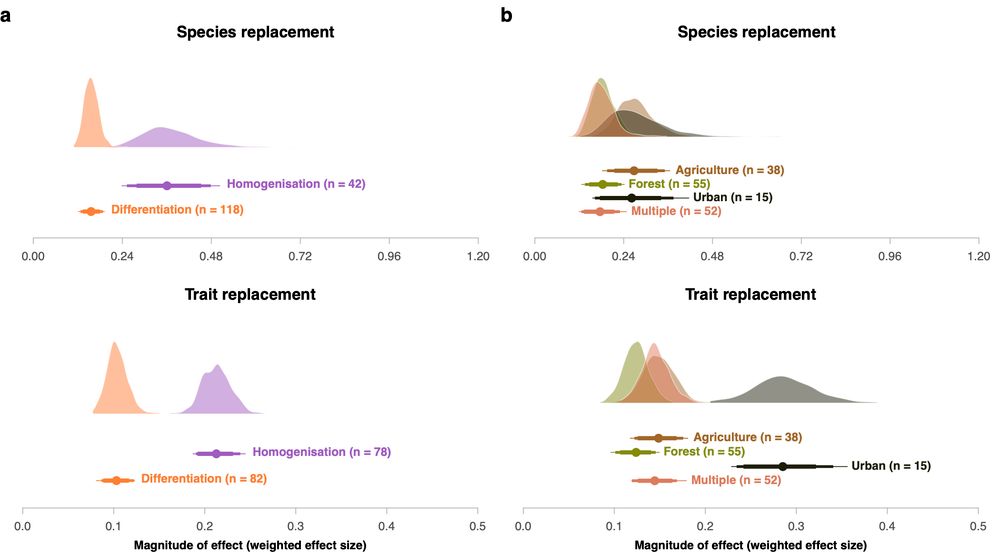
December 4, 2024 at 11:36 AM
6/ 📊 Fig. 3: Homogenisation Hits Harder
Differentiation is more frequent, but human pressures drive homogenisation much more strongly.
Urban areas are hotspots, with 73.3% of urban datasets showing trait homogenisation.
This intense impact leaves ecosystems fragile and less adaptable. 🌇⚠️
Differentiation is more frequent, but human pressures drive homogenisation much more strongly.
Urban areas are hotspots, with 73.3% of urban datasets showing trait homogenisation.
This intense impact leaves ecosystems fragile and less adaptable. 🌇⚠️
5/ 🧩 Fig. 2: Differentiation vs Homogenisation
Differentiation is more common globally (70% of datasets), but freshwater and terrestrial ecosystems show heightened vulnerability to homogenisation—species in 40% of freshwater datasets and traits in 46.3% of terrestrial datasets.
Differentiation is more common globally (70% of datasets), but freshwater and terrestrial ecosystems show heightened vulnerability to homogenisation—species in 40% of freshwater datasets and traits in 46.3% of terrestrial datasets.
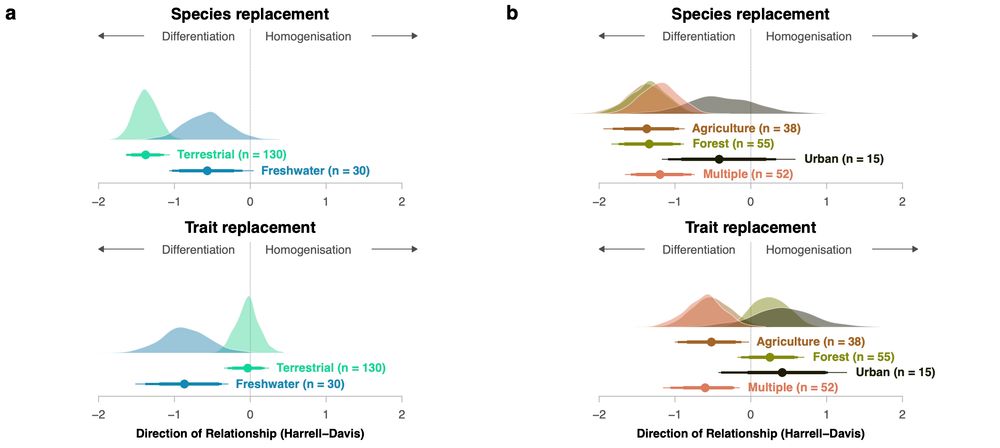
December 4, 2024 at 11:36 AM
5/ 🧩 Fig. 2: Differentiation vs Homogenisation
Differentiation is more common globally (70% of datasets), but freshwater and terrestrial ecosystems show heightened vulnerability to homogenisation—species in 40% of freshwater datasets and traits in 46.3% of terrestrial datasets.
Differentiation is more common globally (70% of datasets), but freshwater and terrestrial ecosystems show heightened vulnerability to homogenisation—species in 40% of freshwater datasets and traits in 46.3% of terrestrial datasets.
4/ 🧩 Fig. 1: Human Pressure > Climate & Geography
Our first key finding: Human pressure (as in human footprint) outweighs climate and geography, being responsible for 21.5% of species turnover and 20.6% of trait turnover.
Human activity reshapes biodiversity far beyond natural gradients. 🏙️🌾🌍
Our first key finding: Human pressure (as in human footprint) outweighs climate and geography, being responsible for 21.5% of species turnover and 20.6% of trait turnover.
Human activity reshapes biodiversity far beyond natural gradients. 🏙️🌾🌍
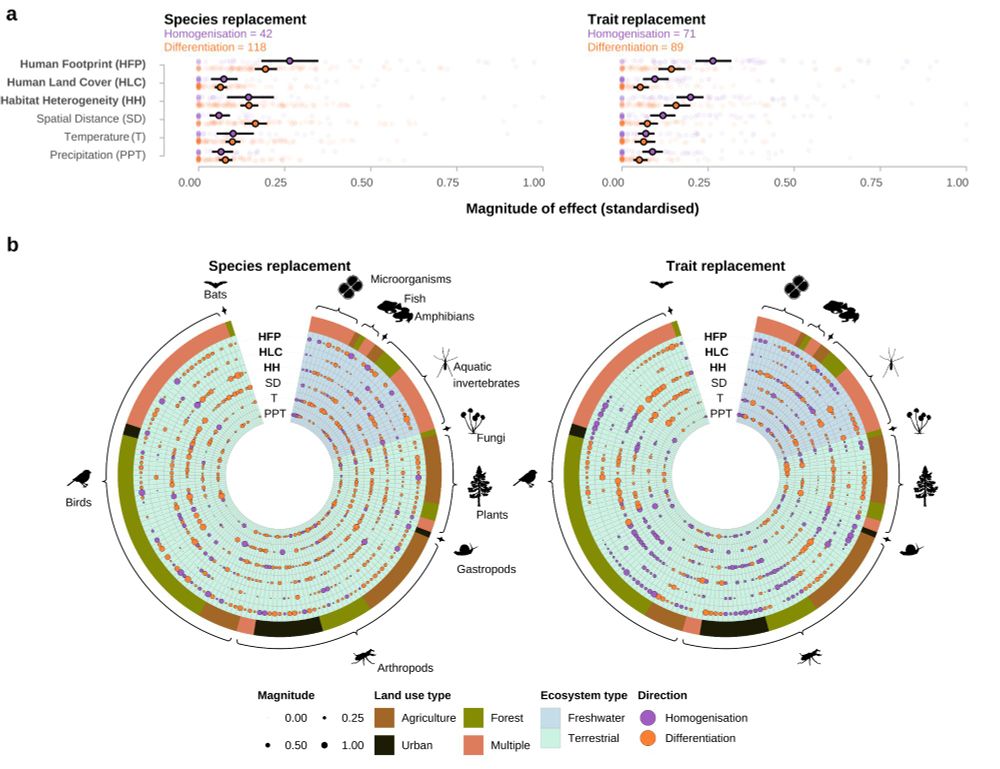
December 4, 2024 at 11:36 AM
4/ 🧩 Fig. 1: Human Pressure > Climate & Geography
Our first key finding: Human pressure (as in human footprint) outweighs climate and geography, being responsible for 21.5% of species turnover and 20.6% of trait turnover.
Human activity reshapes biodiversity far beyond natural gradients. 🏙️🌾🌍
Our first key finding: Human pressure (as in human footprint) outweighs climate and geography, being responsible for 21.5% of species turnover and 20.6% of trait turnover.
Human activity reshapes biodiversity far beyond natural gradients. 🏙️🌾🌍
3/ 🔬 What We Did:
Analysing 160 datasets of over 13,000 local communities across 9 taxa and multiple ecosystems, we studied:
Species turnover (who’s replaced)
Trait turnover (what's replaced)
And how human pressure stacks up against climate or geography.
Analysing 160 datasets of over 13,000 local communities across 9 taxa and multiple ecosystems, we studied:
Species turnover (who’s replaced)
Trait turnover (what's replaced)
And how human pressure stacks up against climate or geography.
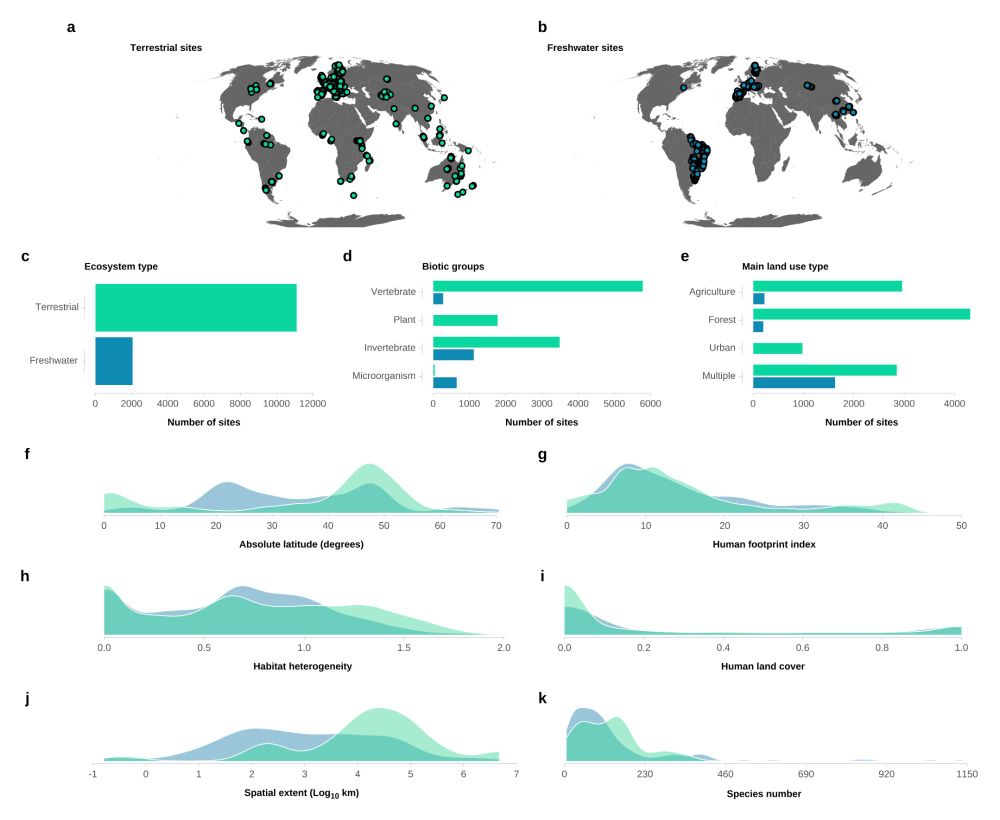
December 4, 2024 at 11:36 AM
3/ 🔬 What We Did:
Analysing 160 datasets of over 13,000 local communities across 9 taxa and multiple ecosystems, we studied:
Species turnover (who’s replaced)
Trait turnover (what's replaced)
And how human pressure stacks up against climate or geography.
Analysing 160 datasets of over 13,000 local communities across 9 taxa and multiple ecosystems, we studied:
Species turnover (who’s replaced)
Trait turnover (what's replaced)
And how human pressure stacks up against climate or geography.
2/ 🌏 The Problem:
Human activities—urbanisation, agriculture, and more—are reshaping biodiversity at a global scale. But HOW do these pressures affect species and the traits they carry? 🤔
Hint: It's not just about losing species; it’s about losing variety.
Human activities—urbanisation, agriculture, and more—are reshaping biodiversity at a global scale. But HOW do these pressures affect species and the traits they carry? 🤔
Hint: It's not just about losing species; it’s about losing variety.
December 4, 2024 at 11:36 AM
2/ 🌏 The Problem:
Human activities—urbanisation, agriculture, and more—are reshaping biodiversity at a global scale. But HOW do these pressures affect species and the traits they carry? 🤔
Hint: It's not just about losing species; it’s about losing variety.
Human activities—urbanisation, agriculture, and more—are reshaping biodiversity at a global scale. But HOW do these pressures affect species and the traits they carry? 🤔
Hint: It's not just about losing species; it’s about losing variety.

